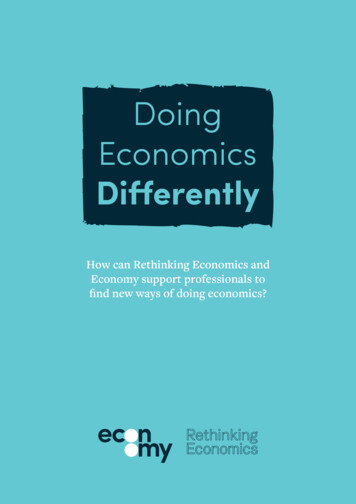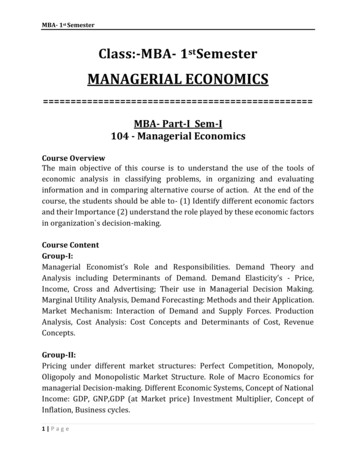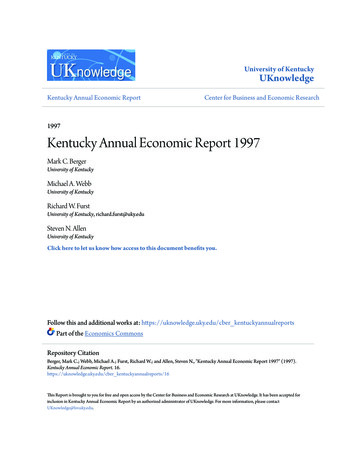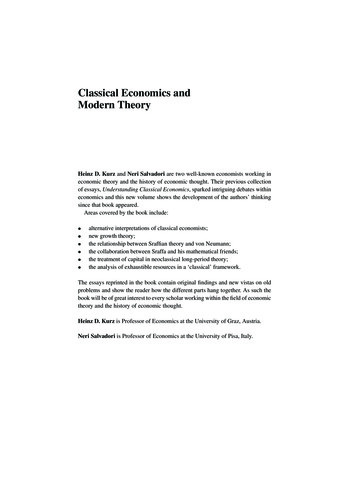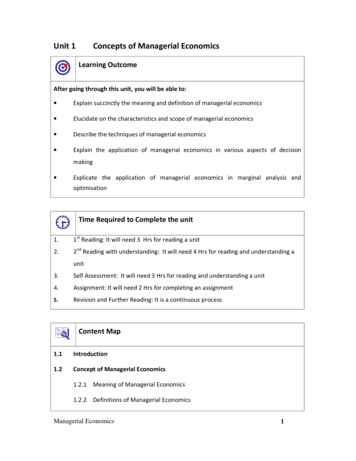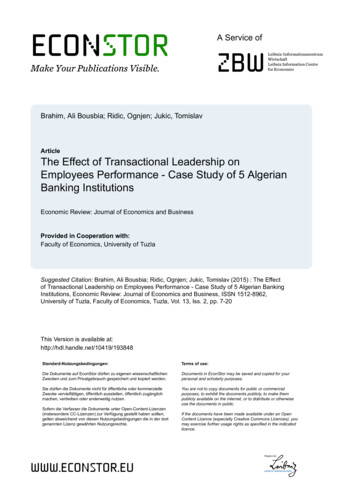
Transcription
econstorA Service ofzbwMake Your Publications iz Information Centrefor EconomicsBrahim, Ali Bousbia; Ridic, Ognjen; Jukic, TomislavArticleThe Effect of Transactional Leadership onEmployees Performance - Case Study of 5 AlgerianBanking InstitutionsEconomic Review: Journal of Economics and BusinessProvided in Cooperation with:Faculty of Economics, University of TuzlaSuggested Citation: Brahim, Ali Bousbia; Ridic, Ognjen; Jukic, Tomislav (2015) : The Effectof Transactional Leadership on Employees Performance - Case Study of 5 Algerian BankingInstitutions, Economic Review: Journal of Economics and Business, ISSN 1512-8962,University of Tuzla, Faculty of Economics, Tuzla, Vol. 13, Iss. 2, pp. 7-20This Version is available ungsbedingungen:Terms of use:Die Dokumente auf EconStor dürfen zu eigenen wissenschaftlichenZwecken und zum Privatgebrauch gespeichert und kopiert werden.Documents in EconStor may be saved and copied for yourpersonal and scholarly purposes.Sie dürfen die Dokumente nicht für öffentliche oder kommerzielleZwecke vervielfältigen, öffentlich ausstellen, öffentlich zugänglichmachen, vertreiben oder anderweitig nutzen.You are not to copy documents for public or commercialpurposes, to exhibit the documents publicly, to make thempublicly available on the internet, or to distribute or otherwiseuse the documents in public.Sofern die Verfasser die Dokumente unter Open-Content-Lizenzen(insbesondere CC-Lizenzen) zur Verfügung gestellt haben sollten,gelten abweichend von diesen Nutzungsbedingungen die in der dortgenannten Lizenz gewährten Nutzungsrechte.www.econstor.euIf the documents have been made available under an OpenContent Licence (especially Creative Commons Licences), youmay exercise further usage rights as specified in the indicatedlicence.
. Economic Review – Journal of Economics and Business, Vol. XIII, Issue 2, November 2015///THE EFFECT OF TRANSACTIONAL LEADERSHIP ON EMPLOYEES PERFORMANCE –CASE STUDY OF 5 ALGERIAN BANKING INSTITUTIONSAli Bousbia Brahim *, Ognjen Riđić **, Tomislav Jukić ***ABSTRACTThe objective of this study was to determinewhatmanagersthoughtabouttheorganizational results performed by utilizingdifferent leadership styles in a part of thebanking sector in Algeria. A quantitative surveyinstrument was designed to analyze theiropinions. Quantitative survey instrument designwas adopted as the most cost efficient for thisresearch. Convenience sampling method wasutilized. As far as the research time frame wasconcerned, it was performed in a crosssectional manner, in the summer of 2014. Outof 174 sent out surveys, the responses werecollected from 132 surveyed individuals. Thesurvey was the main instrument for datacollection and it was designed in a “5 - pointLikert’s scale”, in addition to descriptivestatistics questions. The collected data wereanalyzed with descriptive statistics. Theanalysis of variance (ANOVA) was utilized asthe tool of inferential statistics in order todetermine differences in leadership betweenmultiple groups of respondents, by age groupsand employment within the organization. Theresearch was conducted to see how efficientlyand effectively managers used available humanand other material and financial resources tosatisfy customers and achieve organizationalgoals. The paper investigated the impact oftransactional leadership style on employees’performance in Algerian banks. The objectivesof the study were to determine the relationshipbetween transactional leadership style andemployees performance, The recommendationwas made that managers adopt leadershipstyle(s), such as transformational and Level 5leadership that will enable them to successfullyintegrate and maximize available resourceswithin the internal and external environmentfor attainment of organizational goals.Keywords:Leadership,TransactionalLeadership, Organizations, Performance.JEL: M541 INTRODUCTIONThe concept and definition of leadership andstyle may differ from one person, or situation,to the other. The word “leadership” has beenused in various aspects of human endeavor,such as: politics, businesses, academia, socialworks, etc. Previous views about leadershipshow it as one example of the personal ability.Leadership style in an organization is one ofthe factors that play a significant role inenhancing or retarding the interest andcommitment of the individuals in theorganization. An individual will support anorganization if he/she believes that through ithis/her personal objectives and goals could bemet; if not, the person’s interest will decline.2 LITERATURE REVIEW2.1 Definitions of leadershipLeadership can be defined in different ways;thus, it is difficult to come up with a singleworking definition. In spite of all the researchand theorizing, the concept of leadership isproblematic. As Meindl & Ehrlich (1987)commented: “It has become apparent that,* International University of Sarajevo (IUS), Department of Management, alibousbiasouf@gmail.com** International University of Sarajevo (IUS), Department of Management, oggi.ridic@gmail.com*** Josip JurajStrosmajer University, Osijek, Croatia, jukic.tomi@gmail.com///7
///. Brahim A. B., Riđić O., Jukić T.after years of trying, we have been unable togenerate an understanding of leadership thatis both intellectually compelling andemotionally satisfying. The concept ofleadership remains elusive and enigmatic.Leadership is a process in which leader isindulged in various activities to achieve anygoal”. It may be for one's own goals or for thegoals of others and these goals may or maynot be congruent with organizational goals(Hersey, Blanchard & Dewey 2008). Otherdefinitions (out of many) include: Daft (2014): Leadership is ‘the process ofinfluencing people to enable theachievement of relevant goals’; Goleman (2000): ‘A leader’s singular job isto get results’; House & Aditya (1997): ‘Leadership is theability to motivate, influence and enableindividuals to contribute to the objectivesof organizations of which they aremembers’; Bass (1990): ‘Leadership is an influencingprocess aimed at goal achievement’; Armstrong (2009): Leadership is no morethan exercising such an influence on othersthat they tend to act in concert towards theachievement of a goal that they might nothave achieved so readily had they been leftto their own devices’.2.2Theories of LeadershipVarious perspectives have developed overtime and leadership theories have developedwithin these perspectives. The followingdiscussion contains a number of popular andrecent theories pertaining to the concept ofleadership. “The Trait Approach” that enduredup to the late 1940s claimed that leadershipability is inborn. In the late 1940s to the late1960s,“the Behavioral Approach” becamedominant; advocating that effectiveness inleadership has to do with how the leaderbehaves. In the late 1960s to the early1980s,“the Contingency Approach” becamepopular suggesting that effective leadership is///dependent upon the situation(Jones George2009). Recent approaches to leadership focuson vision and charisma, as such of Max Weber,John Kennedy, Marin Luther King Jr. and SteveJobs, the co-founder of Apple Inc (Robbins Judge 2012). Later, a stream of research hasfocused on differentiating transformationalfrom transactional leaders such as the OhioState studies, Fiedler's model and path-goal.2.2.1 Trait Theories of LeadershipThe Trait Approach arose from the “GreatMan” theory as a way of identifying the keycharacteristics of successful leaders. Also, thisapproach includes the models that attempt toexplainleadershipeffectivenessbyarticulation of physical, psychological andsocial characteristics (McKee 2012).This approach was performed focusing onisolating leader's traits, by idedness, enthusiasm, strength, bravery,integrity and self-confidence.The belief that leaders are born rather thanmade dominated much of the late 19thcentury and the early 20th century. Also, ittried to define any distinguishing physical orpsychological characteristics of the individualthat explains the behavior of leaders(Nahavandi 2009).However, after several years of such research,some shortcomings of this approach wereidentified. Firstly, it is not clarified which ofthe traits are most important and which arenot. Secondly, some traits overlap. Forexample, tact, judgment, and common senseare listed as separate traits but the last onecovers the preceding ones. Thirdly, traitstudies do not distinguish between traitshelping to become a leader and those enablingit to be maintained. Fourthly, most traitstudies are descriptive. There is anassumption that the leader’s traits existedprior to leadership and most of them haveEconomic Review – Journal of Economics and Business, Vol. XIII, Issue 2, November 20158
. The Effects of Transactional Leadership of Employees Performace failed to approach the study of personality asan organized whole (Derel 2003).2.2.2 Behavioral theories of leadershipThe trait approach did not yield the expectedresults. As the need for identifying andtraining leaders came to the forefront duringthe World War II, the previous results ledresearches turn to behaviors, rather thantraits as a resource of leadership effectiveness(Nahavandi 2009).2.2.2.1 The Iowa studiesThe University of Iowa studies conducted inthe United States, explored three leadershipstyles to find which was most effective and todetermine their effect on the attitudes andproductivity of the subordinates (Derel,2003). They identified the Authoritarian,Democratic and Laissez Faire Leadershipstyles. These leadership styles exist on acontinuum from autocratic to laissez-faire.Authoritarian style is characterized by aleader who makes all the decisions and passesthe directives to subordinates who areexpected to carry these out under very closesupervision. It is assumed that the leaderknows everything and knows what is best forthe organization and that the leader hasunlimited authority (Derel 2003).Democratic style is characterized by astructured but cooperative approach todecision making. It focuses on grouprelationships and sensitivity to the people inthe organization. This style fosters to improveprofessional competence and lead them towork as team. It is well suited to theenvironments where people have a very highlevel of expertise such as software engineers,lawyers, doctors, mature teachers, etc. Thedemocratic leadership style promotes greaterjob satisfaction and improved morale(Marturano & Gosling 2008).///2.2.2.2 Laissez-faire styleThis is quite the opposite of the Authoritarianstyle. There is the absence of any realleadership and everyone is free to do as theyplease. Usually, with no targets or direction,there is a state of confusion. As the result of it,productivity is usually very low (Marturano &Gosling 2008).As the leadership studies that were aimed atidentifying the appropriate traits did not yieldany conclusive results, a group of people fromthe Ohio State University developed in the1940s and the 1950s a list of 150 statementsfrom their generated responses that included1,800 statements. The list was designed tomeasure nine different behavioral leadershipdimensions. The resulting questionnaire isnow well-known as the LBDQ or the LeadersBehavior Description Questionnaire. As partof the study, the LBDQ was administered tovarious groups of individuals ranging fromcollege students and their rsonnel.Those researches and studies in Ohio identifytwo basic kinds of leader behaviors that maybe engaged to influence their subordinates,namely Consideration and Initiating on when they show theirsubordinates the trust, openness, and concernfor employees' well being. Learders whoemphasize consideration would likely createtrusting, supportive, and as a result, moreproductive work environment (Jones George, 2009) .Initiating Structure. Leaders engage ininitiating structure when they take steps tomake sure that work gets done. It includesbehaviors related to task and goal orientation,such as giving clear directions, monitoringemployees' performance, and planning andsetting work schedules and deadlines. Leaderswho emphasize structure are likely toEconomic Review – Journal of Economics and Business, Vol. XIII, Issue 2, November 2015///9
///. Brahim A. B., Riđić O., Jukić T.emphasize efficiency and effectiveness tosupport employees by identifying what needsto be done in order for them to succeed at thejob or task (Mckee 2012).2.2.2.3 University of Michigan studiesAround the same time the Ohio Universitystudies were under way, researchers atMichigan University began studying thebehavior of effective leaders. The MichiganUniversity researchers came up with twodimensions behavior. The first one wasemployee-oriented,whichemphasizedinterpersonal relationships by taking apersonal interest in the needs of employeesand focusing on engaging them throughsetting and assisting in the attainment of highperformance targets. The second was theproduction-orientedbehavior,whichemphasized technical or job tasks such asefficiency, costs adhering and so on. Thosedimensions are closely related to the onesidentified by the Ohio State Universitydimensions.performances, lowers employee turnover andabsenteeism and grants employee satisfaction.However, the Team Management style wouldnot work in a crisis, because sometimes thereis no time to be sensitive to moral issues. Inaddition, this model encourages managers todevote more time to managing humanresources, because they usually spend moretime managing easier resources (Bolden et al2003).2.2.2.4 Managerial gridThe Managerial Grid (Figure 1) wasdeveloped by Blake and Mouton, who focus ontask (production) and employee (people)orientations of managers (Bolden et. al 2003).In 1964, they developed two dimensionalviews of leadership style based on the concernfor people and concern for production whichcould be plotted along horizontal and verticalaxes (Mckee 2012).As we can see in this model, there are fiveleadership styles that might fall under:Impoverished Management (1, 1), TaskManagement (9, 1), Middle of the RoadManagement (5, 5), Country Club Management(1, 9), and Team Management (9, 9).As a result, Mouton and Blake concluded thatthe Impoverished Management (1,1) is not themost effective, while Team Management (9,9)is the best style because it improves///Figure 2.1. Leadership GridSource: Bolden et. al 2003.2.3The main types of leadersLeaders have been classified into a number ofdifferent types as described below:2.3.1Transactional leadersAs originally described by Burns (1978), thetransactional leaders identify the expectationsof their followers and respond to them byestablishing a close link between effort andreward. Power is given to the leader toevaluate, correct and train subordinates whenperformance needs to be improved and toreward effectiveness when the requiredoutcomes are achieved (Couto 2007).Economic Review – Journal of Economics and Business, Vol. XIII, Issue 2, November 201510
. The Effects of Transactional Leadership of Employees Performace 2.3.2Transformational leadersAs defined by Bass (1990), the purpose oftransformational leaders is to empower theirfollowers and encourage them to ‘do morethan they are originally expected to do’.Transformational leaders motivate followersto perform at higher levels, to exert greatereffort, and to show more commitment. Bassidentified three principal leadership processesfor achieving various outcomes, such as: (1)heightening followers’ awareness about theimportance and value of designated goals andthe means to achieve them; (2) inducingfollowers to transcend their self-interests forthe good of the group and its goals; and (3)meeting followers’ higher-order needs.Transformationalleadersprovideencouragement and support to followers;assist their development by promoting growthopportunities, and show trust and respect forthem as individuals. They build ///performance indicators to strengthen currentprogram and strategy management. Thosesteps will outline a method for identifyingoutcomes and relevant outputs, developingappropriate performance indicators andstrengthening performance reporting –leading to more effective and efficientprograms and strategies. Those steps arestructured as six steps (shown in Figure 3).Charismatic leadersThey have compelling personalities and theability to rouse people to follow them throughthe sheer force of the impression they make.As originally described by Weber (1947),charismaticleadersareachievementorientated, calculated risk-takers and goodcommunicators. They achieve motivationaloutcomes through four mechanisms: (1)changing follower perceptions of the nature ofwork itself; (2) offering an appealing futurevision; (3) developing a deep collectiveidentity among followers and (4) heighteningboth individual and collective self-efficacy(e.g. people’s belief in themselves and whatthey can do) (Couto 2007).2.4Steps to measure organizationalperformanceThe steps to measure organizationalperformance will assist directorates inselectinganddesigningappropriateFigure 2.2. The steps in measuring performance(Source: Organizational Performancemeasurement and reporting guide, 2013. p. 2)1.Plan: Good planning does not guaranteegood performance, but it can assist indeveloping more robust performancemeasurement systems and finding aclearer course of action. A useful tool inplanning is program logic, which involvesaligning top level company outcomes,company priorities, directorate servicesand costs;2.Select performance indicators: Thissection provides more information onselecting appropriate and measureableperformance indicators. The performanceof programs or strategies should bemeasured at each level of the logic model;Economic Review – Journal of Economics and Business, Vol. XIII, Issue 2, November 2015///11
///. Brahim A. B., Riđić O., Jukić T.3.Conduct program: The project is deliveredto effect change and should beimplemented in line with the programimplementation plan;4.Collect data and monitor performance:Program planning, design and selection ofindicators are key components of aperformancemeasurementsystem.However, these steps are essentiallymeaningless if data is not collectedagainst each of the indicators. Measuringperformance requires the timely andrelevant collation and analysis of data.Data must be gathered by set timeframesand must be accurate, comprehensive andcomparable;5.6.Analyze and report: The utility ofperformance information is limited if it isnot communicated effectively andintegrated back into the planning cycle;Evaluate and modify: Once the data forthe performance indicators are collected,analyzed and communicated, considerevaluatingboththeperformanceindicators selected and the program orstrategy being measured. Evaluating theprogram or strategy can inform leaders’decisions about planning, capability andresource allocation (O.P. Measurement,2013).2.5 Link between transactional leadershipand performanceSince transactional leadership is based on asystem of rewards and penalties, it does notoffer much in terms of inspiration, to motivatepeople to go beyond the basics. Given this fact,the followers of transactional leaders mightget complacent and develop a tendency toachieve minimal expectations only that wouldhelp them avoid penalties (Bass 1990). Thus,the leader and the follower are in anagreement on what the follower wouldreceive upon achieving the negotiated level ofperformance. The success of such leadership///depends on the level of satisfaction the leaderand followers have in following this system ofperformance based appraisals. Thus, theexpected causal chain where leadership stylepositively affects employee motivation, whichtranslates into improved employee andorganizational performance, does not seem tobe applicable to transactional leadership.(Bass 1990) (see Figure 2.3.).LEADERSHIP STYLEaffectsEMPLOYEEMOTIVATIONImproved motivationleads to improvedaffectsEMPLOYEEPERFORMANCEaffectsImproved performance oforganizational employeesleads to improvedORGANIZATIONALPERFORMANCEFigure 2.3. Ali Bousbia B. Master thesis,International University of Sarajevo (2015, p. 37)As a matter of fact, a study conducted byHowell & Avolio (1993) confirms thatcontingent reward leadership has a negativeimpact on the followers' performance.Contingent reward is viewed as "an active andpositive exchange between leaders andfollowers whereby followers are awarded foraccomplishing agreed upon objective". Ifmanagers do not effectively follow-up on thecontingentrewardpromises,therebydisplaying behavioral inconsistency, they areviewed as ineffective leaders. Furthermore,Howell & Avolio (1993) suggest that the levelEconomic Review – Journal of Economics and Business, Vol. XIII, Issue 2, November 201512
. The Effects of Transactional Leadership of Employees Performace of contingent reward leadership is dependenton organizational context and settings. Forexample, an organization undergoing changemight suffer from a transactional leadershipstyle. The penalties, awarded in such a systemof managing by exception, have a negativeimpact on performance and satisfaction. Thisstems from the fact the leader passivelyawaits problems before taking any action. Byfollowing this strategy, the leader ensures thatcorrective action is taken when required andin doing so he reinforces the roles andexpectations for the followers. Hence, thisbehavior represents an important aspect oftransactional leadership (Bass 1990).Jayasingam, Ansari & Jantan (2009) discussedthat the coercive power has been linked withineffective leadership. Transactional leadersmake use of reward and coercive power.Coercive power is based on "the target'sperception that the agent has the ability toinflict various organizational punishments"and it appears that transactional leaders aremore likely to adopt coercive power. Workingin fear of losing one's job, or fear or demotion,only makes an employee ineffective andunproductive because the employee spendsmost of his/her time worrying about theconsequences if the expectations of theleaders are not met.As it can be observed, a transactional leaderrelies heavily on power and authority to leadhis members. Power play and the use of a"reward and penalty" system thus play anintegral role in such a leadership style. Asdiscussed through various researches,transactional leadership measures are not soeffective and in most cases can de-motivateemployees. There are suggestions that effectsof leadership styles on employee performanceare dependent on the organizational contextand settings. If, as Howell & Avolio (1993)argued, an organization undergoing changemight suffer from a transactional leadershipstyle, could the opposite be true? Specifically,if an organization has a long history and///operates under a more or less unchangedbusiness model over a long period of time,could transactional leadership actuallyimprove the organization’s performance?More to the point, is it possible that Algerianbanks’ managers transactional leadershipstyle (of course, if they indeed practice suchstyle of leadership) have tangible effects onemployee motivation?2.6 The categories to measureperformanceFirstly, we need to solve this question, why dowe measure performance? We may say, toevaluate how well (i.e., how effectively,efficiently, and profitability) organizations aredoing in achieving their goals in their missionstatements.Secondly, by which techniques or approachescan we measure performance? Manyresearchers argue that the characteristics forperformancemeasurementwouldbedifferent, depending on the different purposesof measuring performance.2.6.1Accounting measuresAccounting measures represent the mostcommon and readily available means ofmeasuring organizational performance; thevalidity of their use is found in the extensiveevidence showing that accounting andeconomic returns are related. A summary ofaccounting measures is shown as follows: Cash flow from operations; Earnings before interest and taxes (EBIT); Earningsbeforeinterest,taxes,depreciation, and amortization (EBITDA); Market share; Net operating profits (also known asearnings); Net operating profit after tax [NOPAT]; Profit margin; Return on assets (ROA); Return on book-valued assets; Return on capital employed (ROCE);Economic Review – Journal of Economics and Business, Vol. XIII, Issue 2, November 2015///13
/// . Brahim A. B., Riđić O., Jukić T.Return on equity (ROE);Return on investment (ROI);Return on invested capital (ROIC);Variance in accounting profitability;Sales and Sales growth. (Carton & Hoffer2006).2.6.2Financial market measuresA summary of financial market measures isshown as follows: Beta coefficient; Earnings-per-share (EPS); Jensen’s alpha; Market value (or market capitalization)(numbers of shares x price per share); Price-to-earnings ratio (P/E ratio); Return on market-valued assets; Stock price; Total shareholders return (TSR) andTracking stocks.2.6.3 Mixed accounting / financial marketmeasure.An advantage of those measures is that theyare better able to balance risk (largely ignoredby accounting measures) against operationalperformance issues that are sometimes lost inmarket measures. According to Carton &Hoffer (2006) more recent studies haveproduced equivocal results, with accountingmeasures retaining incremental explanatorypower. A summary of those measures isshown as follows: Balanced scorecard, Cash flow per share; Cash flow return on investment (CFROI),Cash value added (CVA); Discounted cash flows (DCF), Economicvalue added (EVA); Internal rate of return (IRR), Market-tobook value; Market value added (MVA), Net presentvalue (NPV); Shareholder value analysis (SVA), Tobin’s q, Total business return (TBR), Warrantedequity value (WEV);/// Weighted average cost of capital (WACC)and Z-score (Pierre et al 2009).2.6.4SurvivalSurvival is a common dependent variable ociologyandentrepreneurship where increasing attentionis given to ecological explanations of firmperformance (DTI, n.d.) (Pierre et al 2009).2.6.5ProfitabilityProfitability is the primary goal of all businessventures. Without profitability the businesswill not survive in the long run. In addition,profitability is measured with income andexpenses and it can be defined as eitheraccounting profits or economic profits(Hofstrand 2009). The reasons for computingprofitability are: firstly, to check the state oforganization; secondly, increasing profitabilityis one of the most important tasks of thebusiness managers, so mangers constantlylook for ways to change the business toimprove profits (DTI, n.d.).We can calculate productivity as outputsdivided by inputs, which can be quoted as:Expected productivity [(expected output) /(resources expected to be consumed)] orActual productivity [(actual output) /(resources actually consumed)] (DTI, n.d.),(Pierre et al 2009).2.6.6EfficiencyEfficiency is the measure of how well or howproductively resources are used to achieve agoal. Efficiency can also be quoted as:Efficiency [(Resource actually used x100%)/ (Resources planned to be used)] (DTI, n.d.)(Jones & George 2009).Economic Review – Journal of Economics and Business, Vol. XIII, Issue 2, November 201514
. The Effects of Transactional Leadership of Employees Performace METHODOLOGY3.1General approachThe data for the study were gathered from132 surveyed employed in five bankinginstitutions in Algeria. The study was carriedout in the summer of 2014, in a crosssectional time-line manner.The survey instrument was then pre-tested. Itwas sent to ten national employees(irrespective of their organizational position)who were not subjects of the study. Based ontheir inputs, the questionnaire was slightlyrevised.The survey was conducted over 67 days (from28-07-2014 to 03-10-2014) by fielding aquestionnaire on hard copies. The researcherchecked for logic and consistency at the timeof data entry and coding.In order to increase the response rate, areminder visit or telephone call was placed toall the participants, one week after the surveyadministration.Selecting a sample is a fundamental elementof a positivistic study. The researcheremployed purposive sampling to selectparticipants that are representative of thepopulation. To do this, the researcherconsidered factors that might influence thepopulation:generaldemographiccharacteristics (gender, age, and education),job description (manager/non-manager), andexperience with organization (length ofemployment with organization), etc. Then theresearcher purposefully selected a samplethat adequately represented the targetpopulation on these variables.This study lies with five institutions bankingin Algeria; Bank of Agriculture and RuralDevelopment,LoanAlgerianPeople,Algerian s Exterior Bank, Albaraka Bank andGulf Bank Algerian.4RESULTS4.1Data analysisIn total, 21 (95.5%) of the managerrespondents were male and one (4.5%) wasfemale.Table 4.1. Respondents’ Gender Frequency –ManagersValidThe researcher wrote an introductory note forthe participants to explain the intent andpurpose of the research and to solicitcooperation. They were advised that theirparticipation in the research project wascompletely voluntary and they were under noobligation to participate; that all informationwould be used only for the purpose of thestudy; and that they could obtain findingsupon request. It was made clear that thisresearch was for the purposes of 3.2Valid PercentEffectivenessisthemeasureofappropriateness of the goals that managershave selected for the organization to pursueand of the degree to which the organizationachieves those goals Effectiveness ca
Leadership, Transactional Leadership, Organizations, Performance. JEL: M54. 1 INTRODUCTION . The concept and definition of leadership and style may differ from one person, or situation, to the other. The word "leadership" has been used in various aspects of human endeavor, such as: politics, businesses, academia, social works, etc.




